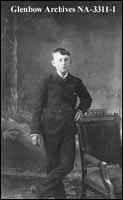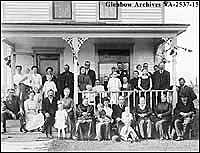Norwegian Settlers
 Norwegian
settlers began arriving in Alberta around 1892, but they had been leaving their
homeland long before. Crop failures, overpopulation, and economic crises had
caused unemployment and misery. In Norway, an underprivileged class had emerged with
less access to education and other opportunities. During the nineteenth century,
many Norwegians had participated in religious and political movements, including the
pietistic movement begun by Hans Nilson Hauge, which stressed the importance of adult
education, political activism, and personal piety, and was supported by the Lutheran
church. Hauge's followers were eager to find a place to live that would endorse their
ideals and, as a result, many crossed the ocean to North America - a place
esteemed by many to be the "land of freedom." Norwegian
settlers began arriving in Alberta around 1892, but they had been leaving their
homeland long before. Crop failures, overpopulation, and economic crises had
caused unemployment and misery. In Norway, an underprivileged class had emerged with
less access to education and other opportunities. During the nineteenth century,
many Norwegians had participated in religious and political movements, including the
pietistic movement begun by Hans Nilson Hauge, which stressed the importance of adult
education, political activism, and personal piety, and was supported by the Lutheran
church. Hauge's followers were eager to find a place to live that would endorse their
ideals and, as a result, many crossed the ocean to North America - a place
esteemed by many to be the "land of freedom."
The first attempts to attract and keep Norwegian settlers in eastern Canada
was a failure. Despite the free land offered and the Norwegians’ willingness
to move, the lack of proper roads and employment meant that most settlers moved
from Newfoundland down to the States.
Edmund Thompson arrived in central Alberta in 1893, one of the first  Norwegian settlers in the area, and one who influenced many of his kinsmen to
follow his example. He worked for many years as a land guide in the latter part
of the 1890s, and actually guided the first residents of Bardo, Alberta to their
homestead in 1894. Evan and Ludvik Olstad, brothers from Norway, came to what
was to become the village of New Norway with other relatives and friends in
1892. Another large number of Norwegian settlers arrived in the area surrounding
present-day Olds and Wetaskiwin in 1903-1904.
Norwegian settlers in the area, and one who influenced many of his kinsmen to
follow his example. He worked for many years as a land guide in the latter part
of the 1890s, and actually guided the first residents of Bardo, Alberta to their
homestead in 1894. Evan and Ludvik Olstad, brothers from Norway, came to what
was to become the village of New Norway with other relatives and friends in
1892. Another large number of Norwegian settlers arrived in the area surrounding
present-day Olds and Wetaskiwin in 1903-1904.
In May of 1904, Ole Bakken built a small store with an upstairs dwelling near
Stoney Creek, and by 1905, the new village of Sparling was beginning to form,
with a harness shop, a hotel, and a "Stopping House."
When the village became a town, the name of Camrose, meaning, "a hill of
roses," was approved.
Many other Norwegian settlers continued to come to Alberta throughout the
early part of the twentieth century, and they were buying land to support their
growing families. According the Census of Canada, there were only 304
Norwegians in the area in 1901 but, by 1911, there were 5,761 people in the province
who had been born in Norway.
See also:
|

|



